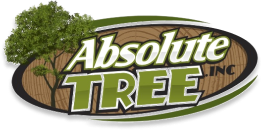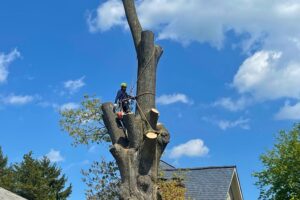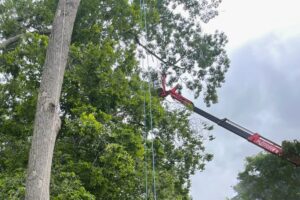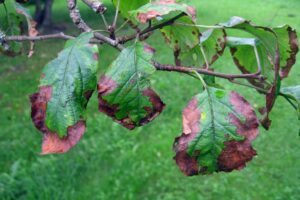Winter storms in Northern Virginia can turn your HOA’s beautiful mature trees into costly liabilities overnight. The recent February 2025 storm that brought ice accumulation and widespread power outages across the region serves as a stark reminder that proactive winter tree planning isn’t just smart management – it’s essential protection for your community’s safety and property values.
Key Takeaways
- October through November is the critical window for scheduling dormant season assessments and pruning before winter weather arrives in Northern Virginia.
- Emergency response protocols developed now can significantly reduce storm cleanup time and restore community access faster than reactive approaches.
- Budget allocation for proactive winter tree care typically costs substantially less than emergency tree removal and property damage repairs.
- Vendor qualification requirements for HOAs should include ISA certification, 24/7 emergency response capabilities, and specialized equipment for tight community spaces.
- Liability protection through documented hazard removal creates defensible records for insurance claims and reduces board exposure to negligence claims.
- Community property values benefit significantly from well-maintained mature trees compared to those with visible tree hazards or recent storm damage.
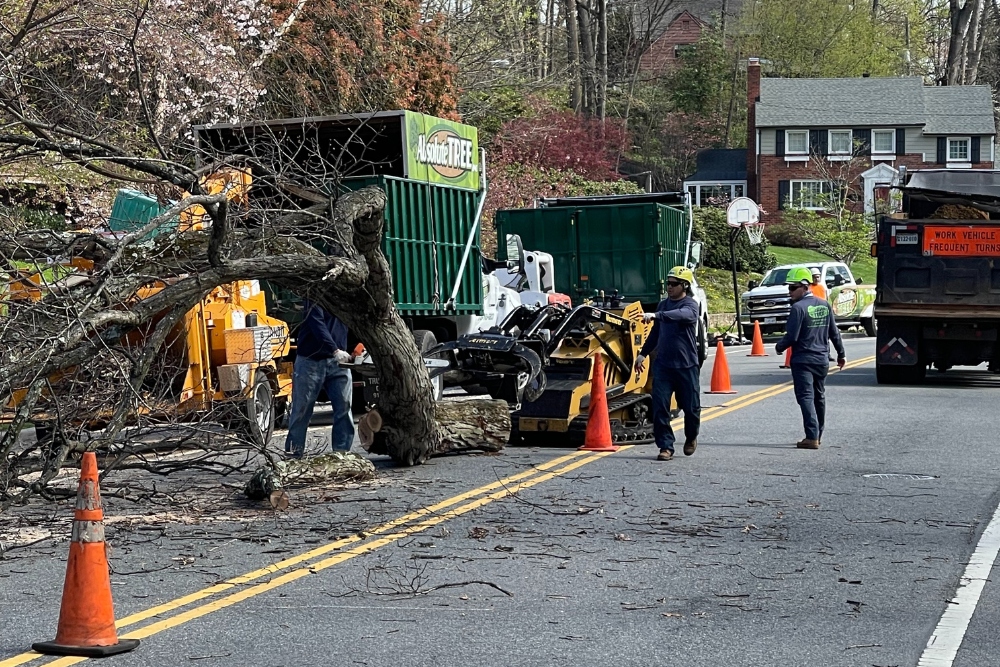
Professional emergency response teams restore community access quickly after winter storm damage.
Common Winter Tree Risks for HOA Communities in Northern Virginia
The unique character of Northern Virginia’s established neighborhoods creates distinct winter tree management challenges that many HOA boards don’t fully understand until it’s too late. Communities like Rosemont in Alexandria, with their early 20th-century homes nestled under mature sycamores and maples, face concentrated risks when winter storms arrive.
Recent weather patterns have intensified these concerns. The January 2025 winter storm brought ice accumulations up to half an inch across the region, causing widespread tree failures and power outages. Governor Youngkin’s emergency declaration highlighted how quickly tree-related damage can escalate into community-wide crises.
” When trees come down in a storm, it’s chaos for a community. Having a winter tree plan means you’re not scrambling – you already know who to call, which trees were flagged, and how to keep residents safe. ” – Ashley Davis, Owner of Absolute Tree Service Owner
Property damage from tree failures during winter storms can result in substantial costs for temporary housing, utility restoration delays, and community reputation impacts that affect property values and resident satisfaction.
Why October is the Perfect Time to Start Your HOA Winter Tree Planning
October represents the ideal time for HOA winter tree planning in Northern Virginia, offering multiple advantages for communities preparing for the season ahead. As deciduous trees begin shedding their leaves, arborists can more easily identify structural issues and potential hazards that remain hidden during the growing season.
The mild, typically dry weather provides optimal conditions for assessment and maintenance work at standard rates, before emergency conditions drive up costs.
This timing provides several key benefits:
- Clear visibility of the tree structure once leaves begin to fall
- Mild weather conditions are ideal for thorough assessments and maintenance
- Sufficient lead time for HOA board approvals and budget decisions
- Ability to schedule dormant season pruning in the optimal November-March window recommended by the Virginia Department of Forestry
- Opportunity to address potential hazards before winter storms arrive
Essential HOA Tree Services for Winter Readiness
Preparing HOA communities for winter requires more than standard tree care. Key services include:
- Hazard Tree Assessment: Systematic evaluation of trees that could impact buildings, walkways, parking areas, or neighboring properties. Arborists use standardized risk assessment protocols to prioritize action.
- Deadwood Removal: Ice and snow can triple branch weight, making dead or weakened limbs a major hazard. Removing dead, dying, or structurally compromised branches reduces the risk of breakage during storms.
- Structural Support Systems: Cabling and bracing provide extra protection for valuable mature trees with minor defects. This is especially important in historic neighborhoods like Old Town Alexandria, where preserving heritage trees maintains both character and property value.
How to Develop Your HOA Emergency Tree Response Plan
Effective emergency tree response planning requires clear protocols that can be implemented quickly during high-stress situations. The plan should address immediate safety concerns, resident communication, vendor coordination, and post-storm assessment procedures.
Your emergency contacts should include multiple pathways for reaching key personnel, recognizing that storm conditions often disrupt normal communication channels. Primary contacts should include:
- Your property management company
- 24/7 emergency tree service providers
- Local utility companies
- Municipal emergency services
Resident communication protocols need to address both immediate danger situations and ongoing cleanup coordination. Effective plans include multiple communication methods:
- Text alerts
- Community bulletin boards
- Social media updates
Communities should establish clear messaging about when residents should avoid common areas, how to report damage, and what cleanup activities are restricted until professional assessment is complete.
SAFETY REMINDER: Never allow residents or maintenance staff to approach damaged trees without a professional assessment. Trees under stress from storm damage can fail without warning, creating extreme safety hazards even days after the initial storm event.

Integrated winter services including snow removal simplify vendor management for HOA communities.
What to Look for When Hiring HOA Tree Services
Selecting qualified tree service providers for HOA winter planning requires careful evaluation of credentials, capabilities, and community-specific experience. Key qualifications include:
- ISA Board Certified Master Arborist on Staff: Advanced expertise in complex tree management situations
- TCIA (Tree Care Industry Association) Accreditation: Demonstrates commitment to industry best practices and safety protocols
- Documented 24/7 Emergency Response: Local equipment staging and crew availability during storm events
- Specialized Equipment for Tight Spaces: Appropriate equipment for communities with narrow streets and limited access
- Integrated Winter Services: Companies offering coordinated services, like commercial snow removal, can simplify vendor management
How Should HOAs Budget for Winter?
Strategic budget planning for HOA winter tree management requires understanding both predictable annual costs and potential emergency expenses. Effective planning balances proactive maintenance investments with appropriate reserve fund allocations for emergency response.
Emergency tree removal during winter storms commands premium pricing due to hazardous working conditions, urgent response requirements, and limited vendor availability. Reserve fund planning should account for the potential for significant winter tree events, with costs varying significantly based on community size, tree density, and storm severity.
BUDGET TIP: Communities that invest in comprehensive proactive tree care typically experience substantially lower emergency tree costs over time compared to those using purely reactive approaches.
Cost-benefit analysis should include often-overlooked factors like insurance premium impacts, property value effects, and resident satisfaction considerations. Well-maintained trees significantly increase property values in Northern Virginia markets, while visible tree hazards or recent storm damage can depress values and slow home sales within the community.
Winter Tree Care Planning for Northern Virginia’s Historic Neighborhoods
Northern Virginia’s historic communities face unique winter tree planning challenges that require specialized knowledge and careful coordination with preservation requirements. Old Town Alexandria’s strict historic preservation guidelines require advance approval for tree work in designated historic districts, making advance planning essential for winter preparation.
Heritage tree protection protocols in communities, like Hollin Hills, require a careful balance between safety needs and preservation goals. Specialized equipment needs for historic communities often center on access limitations and structure protection requirements.
Frequently Asked Questions About Winter Tree Planning
What qualifications should HOA boards require when selecting tree service vendors?
Essential vendor qualifications include ISA Certified Arborists on staff (preferably with an ISA Board Certified Master Arborist as well), TCIA accreditation, comprehensive insurance coverage, documented 24/7 emergency response capabilities, and experience working in HOA communities. Vendors should also have appropriate equipment for working in confined spaces typical of established Northern Virginia neighborhoods.
How should HOA communities handle emergency tree situations during winter storms?
Emergency response should prioritize immediate safety through area evacuation and professional assessment. Communities should have pre-established contact protocols for 24/7 emergency tree service providers, utility companies, and municipal emergency services. Never allow residents or maintenance staff to approach damaged trees, as storm-damaged trees can fail without warning, even days after the initial event.
Who is liable when HOA trees cause damage to individual homeowner property?
Liability typically depends on tree ownership and prior knowledge of hazards. HOA communities are generally responsible for trees in common areas and may be liable for damage if they had prior knowledge of hazardous conditions and failed to address them. This is why documented professional assessments and prompt action on identified hazards are essential for liability protection.
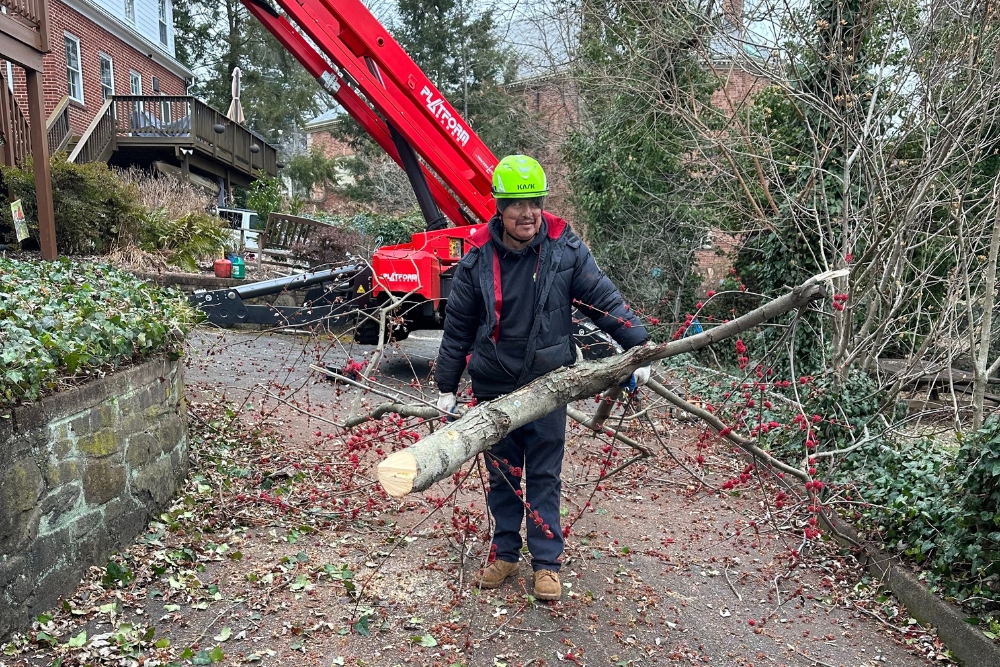
ISA Certified Arborists use specialized equipment for safe tree work in confined HOA community spaces.
Protect Your Community with Professional Winter Tree Planning from Absolute
Effective HOA winter tree planning requires professional expertise, proactive strategies, and reliable partnerships with qualified tree care providers. The mature trees that define Northern Virginia’s most desirable neighborhoods represent significant community assets that deserve protection through comprehensive winter preparation.
Absolute Tree Service brings unique qualifications to HOA winter tree management, with over 19 years of experience serving in Northern Virginia’s established communities. Our integrated services provide a coordinated winter weather response that simplifies vendor management while ensuring community safety.
Don’t wait for the next winter storm to test your community’s preparedness. Contact Absolute Tree Service today at 703-969-6207 or request an estimate online to schedule your comprehensive winter tree assessment and develop the proactive management plan your HOA community needs.
For the Absolute Best Tree Service in Northern Virginia, call Absolute Tree Today!
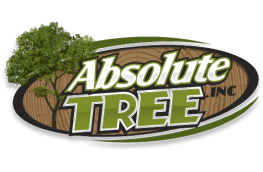
Author Profile: Ashley Davis
Over the last 19 years, Absolute Tree has grown a reputation as one of the premier tree service companies in the Northern Virginia areas. And there’s a good reason for this—we love trees and our passion for them shows. When you call on Absolute Tree for tree service, you aren’t just getting “some guys who cut down trees.” You’re hiring highly skilled arborists who understand the growth of trees and consider tree care an art form.
Stay Up-to-date!
Swing in each month for new articles, pest alerts, local resources, tree care tips, tree health updates, and landscape maintenance ideas
